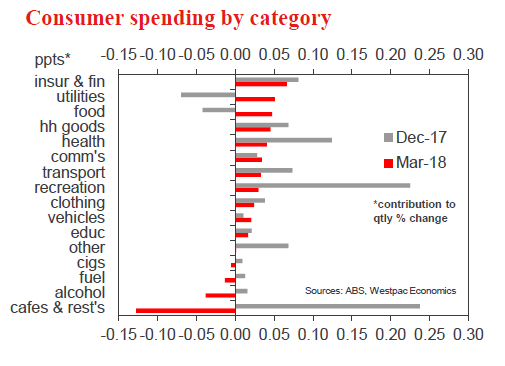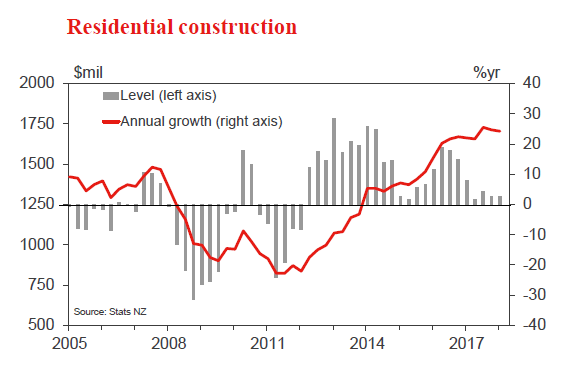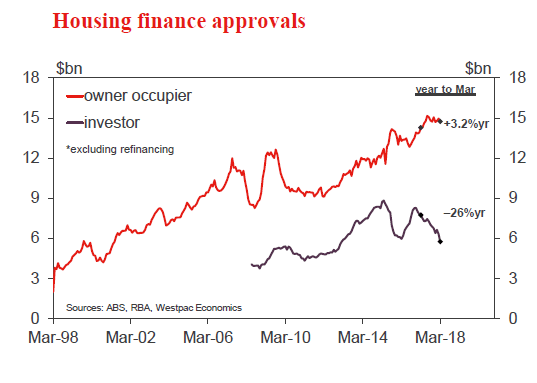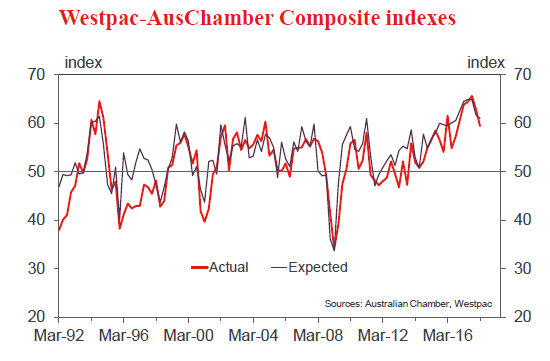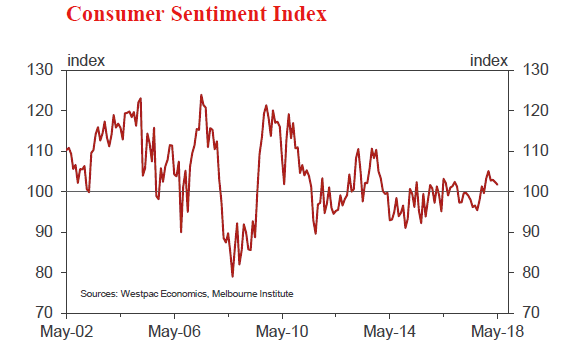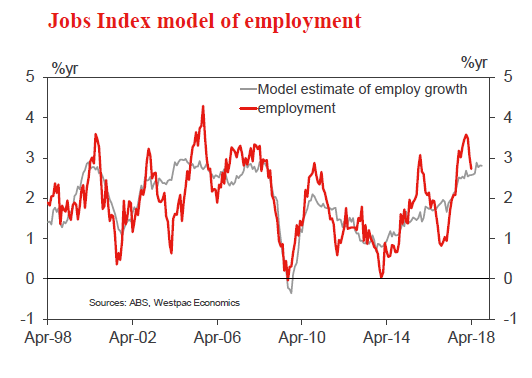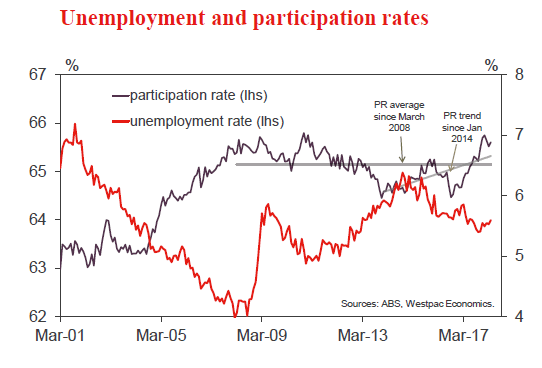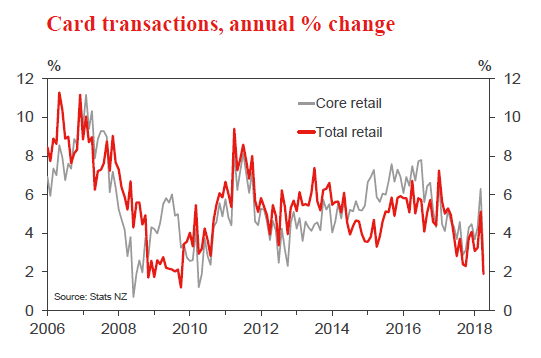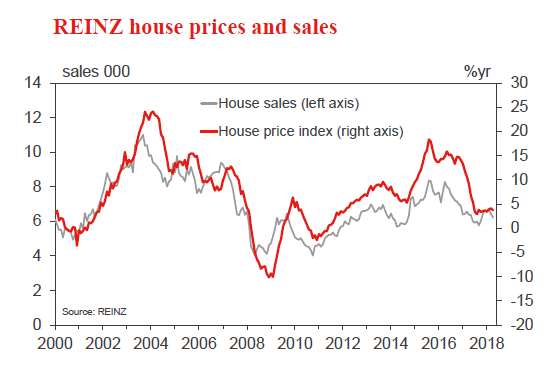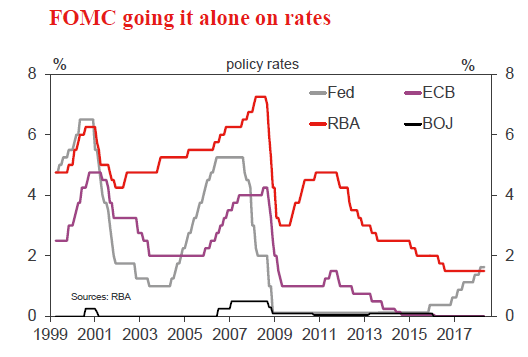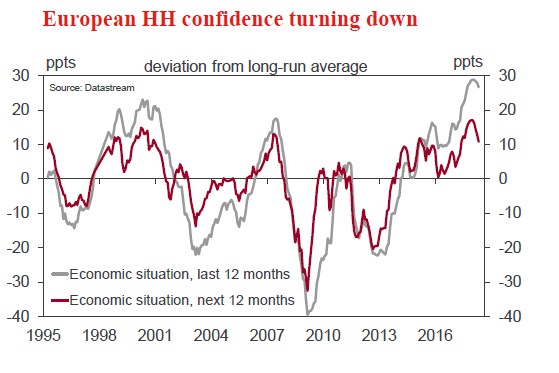Week beginning 11 June 2018
- Public demand and exports lift Australian growth above trend, but consumer still patchy.
- RBA: Governor Lowe and Assistant Governor Economic Ellis speak.
- Australia: Westpac-MI Consumer Sentiment, employment, housing finance, Westpac- AusChamber Manufacturing Survey.
- NZ: retail card spending, house sales & prices.
- China: new loans, retail sales, industrial production, fixed asset investment.
- US: FOMC policy decision & press conference, CPI, retail sales.
- Central banks: ECB and BOJ policy decisions.
- Key economic & financial forecasts.
Information contained in this report current as at 8 June 2018.
Public Demand and Exports Lift Australian Growth above Trend, But Consumer Still Patchy
The Australian economy performed solidly over the past year as evident from labour market trends and as confirmed in the March quarter National Accounts. However, areas of weakness persist and are likely to weigh on the outlook.
Output increased by 1.0% in the March quarter, lifting annual growth to 3.1%. This is an above trend outcome, with trend judged to currently be around 2.7%. Non-farm GDP grew by 3.6% over the year, the strongest annual outcome since 2012. Domestic demand is expanding by a little in excess of 3%, +3.2% over the past year, well up from the sluggish outcomes of around 1% prevailing over 2013, 2014 and 2015.
GDP increasing by 3.1% over the year, and by 3.6% for the nonfarm economy, brings output growth more in to line with job creation, with employment growth a brisk 3.5% over the year.
Economic conditions have been supported by a combination of powerful global and domestic forces, namely:
(1) The global backdrop is more favourable. World growth accelerated in 2017 to 3.8%, up from 3.2%, the strongest pace since 2011. We expect world growth to hold around this 3.8% pace in 2018, supported by a strengthening of conditions in the US. However, conditions in our number one trading partner, China, are likely to moderate somewhat this year.
(2) Commodity prices are up off the lows of late 2015 and early 2016, improving cash flows for miners and triggering a shift away from the earlier cost cutting mindset. Higher commodity prices have also supported government tax revenue collections.
(3) The mining investment drag is greatly diminished, albeit not quite complete, with the remaining gas projects under construction to be completed over the coming year.
(4) Non-mining investment is trending higher, led by construction activity, as the capital stock expands to meet the needs of a fast growing population.
The upshot is that business investment turned the corner in 2017, up 6%, following four years of decline, averaging -7.5% per year. In Q1, business investment consolidated, +0.1%, constrained by a dip in non-residential building work, which will be quickly reversed given the strength of approvals.
(5) Public demand, a quarter of the economy, is expanding at a well above trend pace. Investment is in an upswing, up from the lows of 2015, and additional resources are being directed to health. In Q1, public demand grew by 1.0%qtr, 5.5%yr, directly adding 1.3ppts to activity over the year, with additional positive spill-over effects.
(6) Exports are a growth driver, directly adding 0.9ppts to activity over the past year. LNG exports are expanding strongly as new capacity comes on stream and service exports have been growing solidly, although current estimates suggest a recent consolidation (one that may well be revised up as additional information becomes available).
Supply disruptions have contributed to a choppy export profile, with flow-on effects to activity. Net exports swung from a 0.65ppts subtraction in Q4 to a positive contribution of 0.35ppts in Q1.
These global and domestic developments have led to conditions becoming more synchronised across the state economies, contributing to a stronger national result. This is particularly evident in job trends, with employment trending higher across each of the major states during 2017.
We have recognised the significance of these key themes, which were broadly confirmed in the March quarter National Accounts.
Equally, there are some prevailing weaknesses, particularly around the consumer and housing. The consumer remains vulnerable at a time of weak wages growth, high debt levels and slipping house prices. The housing sector is cooling as lending conditions tighten, with prices easing back from recent highs.
Consumer spending has been mixed in early 2018, expanding just 0.3% in the March quarter, keeping annual growth at 2.9%. Household demand is tracking ‘slightly below trend’ and remains choppy. The absence of above trend consumer spending remains a striking feature of the post GFC period, contributing to the absence of material inflation pressures.
We assess that the current pace of consumer spending is likely unsustainable and anticipate a moderation in spending growth to around 2.5% for the 2018 year as a whole and to remain at this rate for 2019. Notably, consumer spending has also been supported by a moderation in the savings rate, declining from 4.0% a year ago to a relatively low 2.1% currently. The scope for a further run-down of the savings rate is now diminished.
On incomes, total labour income posted a solid 1.1% rise in the March quarter. This, along with upward revisions, lifted the trajectory for annual growth. At 5.1%yr it is now running at the fastest pace since June 2012, although it is still half a per cent below the average over the last fifteen years. Labour income is showing a particularly sharp turnaround in the mining states, annual growth now tracking at just over 5% in both Qld and WA.
However, the key point is that strength in labour incomes is largely centred on the recent hiring burst, which has subsequently faded. Wages, as measured by average compensation of employees (non-farm) grew by only 1.6% over the year to be flat in real terms. Weakness in wages growth reflects, among other things, ongoing labour market slack.
Momentum shifts in jobs growth have been quite marked. An undershoot in 2016, associated with uncertainty around the Federal election, was followed by a hiring burst, in part a catch-up. Jobs growth of 3.5% in the year to the March quarter 2018, which is twice population growth, is unsustainable. Indeed, employment growth has subsequently slowed, to 1.3% annualised for the initial four months of 2018 – for the full year we expect jobs growth of around 1.8%.
As to home building activity, this contracted by 5.0% in 2017, consistent with the decline in dwelling approvals from the historic highs of 2016, largely centred on high rise projects. This downturn has further to run with the contraction accelerating into 2019 after a near-term consolidation over the first half of 2018 (home building actually made a small positive contribution to growth early in 2018). Large increases in new supply and a marked slowdown in sales to foreigners are weighing on the outlook for residential building.
Another consideration is the potential for heightened political uncertainty ahead of the next Federal election, due by mid-2019, which could see businesses delay spending and hiring.
In summary, key positives around pubic demand, business construction investment and exports will provide a solid base for overall economic activity during 2018. However, with weaknesses in consumer spending and housing we expect GDP growth to moderate to 2.7% in the year to December 2018 and then slip to a below trend 2.5% for December 2019.
The week that was
This week, the focus was Australian Q1 GDP. Albeit a little dated, the report provides an overview of the state of the Australian economy no other release can match.
The March quarter GDP outcome was stronger than the market had anticipated, with a gain of 1.0% for the three months to March leaving annual growth at an above-trend 3.1%. Full detail on our thinking can be found on the previous page.
Our first look at retail spending in Q2 (the April monthly retail sales survey) continued to point to underlying weakness in consumption. Sales in the month were a touch above the market expectation, but annual growth slowed to just 2.6%yr. By state, over the year, sales were robust NSW and Vic, but broadly flat in Qld and SA.
By sector, sales growth was also mixed, with clothing and department store sales remaining under pressure, while online trade and cafes & restaurants saw solid gains, along with basic food retail. If, as we anticipate, the soft consumer trend persists, then the RBA will be firmly on hold through both 2018 and 2019.
Finally for Australia, this week the balance of payments release offered a timely update on how we fund ourselves as a nation. The latest data from the ABS again highlight that, with portfolio and ‘other’ (deposits and loans) inflows largely offsetting each other over the past 15 months (to March 2018), direct investment has remained Australia’s net funding source.
With the mining investment boom over, this inflow of capital shows strong foreign investor demand for existing assets in Australia across a wide array of industries. Being primarily equity based, it is therefore long-term in nature.
The strength of direct investment in recent years has been an ‘x factor’ for the currency, holding it at a higher level than interest rates and commodity prices would have by themselves. We anticipate this inflow of capital will slow going forward, but there is little evidence it will do so quickly.
Quickly on commodity prices’ influence on the currency, coal prices remain elevated, but firmer met coal supply from China should weigh in time.
Lastly on the global economy, this week has continued to emphasise that resolving current trade tensions will be difficult and time consuming. Following our video update on Europe at the beginning of the week, European officials retaliated against the US’ move on aluminium and steel. We wait to see if the US will exacerbate tensions or instead seek to negotiate.
As highlighted in the video, trade and political tensions make it increasingly likely that the region’s true core issue (an absence of political reform) will remain entrenched and see growth slow materially through 2018 and 2019. The long-term growth potential of the region needs to be focused upon, not short-term instability.
In stark contrast, the US’ domestic economy continues to fire. One example of this is the US’ housing market where income growth; lower debt (relative to income); and still-low interest rates are providing a strong foundation for robust gains. The flip-side of continued price gains however is deteriorating affordability. This will see new construction split between single homes in the suburbs for owner occupiers and buildto- let developments in cities where (a lack of) affordability is most pressing. The home-ownership rate will therefore remain depressed.
Diverging growth prospects for Europe/US and a number of domestic challenges suggest greater caution is warranted in assessing the outlook for Asia as well. In the latest update, we have seen a continued slowing in growth momentum in advanced Asian PMIs.
Chart of the week: National accounts, spending overseas
Consumer spending came in well below expectations for the quarter, rising just 0.3% vs our expectation of a 0.6% gain. Upward revisions to previous quarters partially offset with annual growth at 2.9%yr still close to our expected 3%.
A significant portion of the Q1 weakness appears to be due to a pull-back in spending by Australian tourists abroad. Consumption includes spending by Australians abroad and excludes domestic spending by non-residents in Australia. The detail from yesterday’s Balance of Payments release showed outbound tourism spending fell 3.3% in real terms in Q1. Notably, two heavily tourism-affected items account for the lion’s share of the Q4 slowdown – ‘cafes & restaurants’ and ‘recreation’ together accounting for 0.56ppts of the 0.68ppt turnaround.
It should also be noted that the contribution from net tourist spending has been a problem area for the ABS recently with technical changes seeing a particularly big revision last quarter.
New Zealand: week ahead & data wrap
In previous years, New Zealand was an outperformer on the global stage. Our solid rates of GDP growth encouraged high levels of net migration, and that in turn reinforced the strength in demand. More recently, however, we’ve seen the momentum in domestic activity fading, while conditions in other economies have firmed. We expect that the New Zealand economy will continue to underperform its peers for the next few years, and this will have important implications for both net migration and the NZ dollar.
With slowing GDP growth, New Zealand’s position on the global stage is starting to slip
As we’ve been highlighting in recent weeks, New Zealand’s economic cycle has now entered a more mature phase. Earlier in the decade, we were an outperformer on the global stage, with GDP growth running at rates of around 3.5% to 4% p.a. That was well ahead of what we were seeing in other developed economies, including Australia and the US.
Earlier drivers of growth, which included house prices and construction activity, have now moved into new phases and are providing less of a boost to economic activity than they once did. This has already seen annual GDP growth cool to 2.9% at the end of last year. And recent updates on economic activity indicate that growth has continued to soften in the early part of 2018. Notably, retail spending was softer than expected in the March quarter, rising by only 0.1%. On top of that, construction activity fell by 0.9% in the March quarter and has essentially been flat for around three quarters now. Underlying this softness in construction, home building has been trending broadly sideways since mid-2016. That pre-dates any uncertainty associated with the change in Government, and highlights the brake that capacity constraints and difficulties accessing finance are having on building activity, regardless of the large pipeline of work that is planned.
Putting it altogether, it now looks like GDP growth in the March quarter could be around 0.5% or even a little lower. That would pull annual GDP growth down to around 2.8%, which would be the slowest pace since 2014.
Softening GDP growth will be reinforced by a slowdown in net migration …
The slowdown in GDP growth has seen New Zealand’s position on the global stage slipping from ‘rock star’ to ‘support act’, as growth in other developed economies has lifted. In particular, we’re now underperforming the Australian economy, where GDP grew by 1% in the March quarter, to be up 3.1% over the past year.
The changes in New Zealand’s relative standing in the global economy will have some important implications. One key area that will be affected is net migration. In recent years, our favourable economic conditions and jobs growth made New Zealand a very attractive destination. That saw a strong lift in new arrivals to the country. It also encouraged larger-thanusual numbers of New Zealanders to remain onshore or come back from abroad (especially from Australia). Combined, those factors saw annual net migration rise to a record high of 72,000 in mid-2017, and pushed the rate of overall population growth above 2% p.a. That provided a powerful boost to demand and our productive capacity, reinforcing the other factors that were supporting growth.
Net migration has been softening in recent months, slowing to a still elevated level of 67,000 in the year to April. We expect that it will slow substantially more over the next few years, as the New Zealand economy starts to lag its peers like Australia and the US. This will exacerbate the more general softening in economic growth, with smaller additions to our demand base, as well as reducing the degree of pressure on new home building (at least outside of Auckland).
…however, a lower NZ dollar will provide a buffer
The other area where the New Zealand economy’s underperformance will really matter is the exchange rate. In recent years, strong economic conditions saw the Kiwi soaring to 88 cents against the US dollar, and at one stage we flirted with parity relative to the Australian dollar.
The NZD/USD is now back around US$0.70, and we expect it will fall to around US$0.64 over the coming year. Strengthening US conditions are likely to see the Fed continuing to gradually hike the Federal Funds Rate, while softening economic conditions in New Zealand will keep the RBNZ on the sideline for some time yet.
The Kiwi has also lost some altitude against its Aussie counterpart, and is now down around AU$0.92. With the RBA expected to remain on hold for even longer than the RBNZ, we see less downside on this front. Nevertheless, with Australia’s relatively firmer economic outlook, we expect the NZD/AUD cross rate will ease back to around AU$0.90 by the start of next year.
The depreciation of the NZ dollar over the coming year will provide a buffer for the economy, boosting export returns and cushioning the effects of slowing activity in other parts of the economy.
Data Previews
Aus Apr housing finance (no.)
- Jun 12, Last: –2.2%, WBC f/c: –3.0%
- Mkt f/c: -1.8%, Range: -3.0% to -0.5%
After holding relatively steady through most of 2017 and early 2018, Australian housing finance approvals showed a notable pull back in March. The total number of owner occupier approvals declined 2.2% to be down 3.5%yr but the real weakness was around the value of investor approvals which dropped 9%mth to be down 16.1%yr (estimates of investor approvals ex refi look to be down over 30% from their 2016 peak). Combined, the total value of approvals ex refi fell 4.6%mth to be down 6%yr.
Industry figures suggest owner occupier approvals declined again in April – we expect the official figures to show a 3.0% drop. Housing markets remained soft but stable through the month. More recent data suggests the Sydney and Melbourne markets have seen a further deterioration through May and early June, likely relating to tightening lending standards.
Aus Q2 AusChamber-Westpac survey of Industrial Trends
- Jun 12, Last: 58.3
The Australian Chamber-Westpac survey of the manufacturing sector provides a timely update on conditions in the sector and insights into economy-wide trends. The Actual Composite tracks a range of demand related measures including investment and employment. The Q2 survey was conducted after the Federal budget during May and the start of June.
In Q1, the Actual Composite moderated to 58.3 from 63.4 in Q4, after an uptrend to 65.7 in September 2018 from a base in June 2015 of 55.1. Strength is centred on a lift in new orders and output as well as increased overtime and an uplift in employment.
Manufacturing is benefitting from a rise in public infrastructure, non-mining business investment, and above par world growth with a relatively low AUD. However, against this are moderate consumption constrained by slow wage growth and the fading of the homebuilding boom.
Aus Jun Westpac-MI Consumer Sentiment
- Jun 13 Last: 101.8
After a promising start, sentiment has drifted lower as the year has progressed. The index slipped to 101.8 in May despite what appeared to be a relatively well-received Federal Budget that included the announcement of personal income tax cuts. While it is still above 100, indicating that optimists outnumber pessimists, the sentiment index is well below the 105–115 levels typically associated with a robust consumer. Family finances remain a clear area of weakness.
The June survey is in the field from June 4-9. Factors that may influence this month include: a strong March quarter GDP result with growth lifting above 3%; continued slippage in dwelling prices, now down 1.1%yr nationally; a further rise in petrol prices, average pump prices hitting $1.53/ litre nationally in early June, up over 20c since mid-March. Financial markets were subdued, the ASX retracing 1% after a 5.7% surge last month and the AUD down over 1c vs the USD.
Aus May Labour Force – total employment ‘000
- June 14, Last 22.6k, WBC f/c: 17k
- Mkt f/c: 19k, Range: 8k to 32k
Employment rose 22.6k in April beating both the market (20k) and Westpac’s (17k) expectations. Full-time employment rose by 32.7k while part-time fell 10.0k. Past employment results were revised with March now –0.7k (was +4.9k) and February is now –7.4k (was reported as –6.3k last month and originally reported as +17.5k).
The three month average gain in April was just 4.9k compared to an average of 27.7k for the previous year. Momentum in employment stalled in early 2018 and annual employment growth dipped to 2.7%yr from a January peak of 3.6%yr. The six month annualised pace is now 2.5% while the four month annualised pace is just 1.3%yr.
The leading indicators are still pointing to sound monthly employment prints as is estimates of population growth. However, due to base effects our forecast +17k gain in employment has the annual pace dipping to 2.6%yr.
Aus May Labour Force – unemployment rate %
- June 14, Last 5.6%, WBC f/c: 5.5%
- Mkt f/c: 5.6%, Range: 5.4% to 5.6%
Despite a sound print on employment in April the unemployment rate rose to 5.6%, (5.60% at two decimal places) a full percentage point on 5.5% in March (5.53% at two decimal places). This jump was due to a 33.2k lift in the labour force with participation bouncing to 65.61%.
The strength in female participation has been driving the overall lift in participation. However, it is the weakness in male employment, given the recent strength male participation, that is behind the lift in unemployment.
We are forecasting a flat participation rate for May which means that after rounding, the forecast +17k in employment is enough to lower the unemployment rate to 5.5%.
NZ May retail card spending
- Jun 12 Last -2.2%, WBC f/c: +1.6%
Retail card spending fell by 2.2% in April. That followed a large gain in the previous month, which may have been affected by the timing of the Easter holiday. Nevertheless, the size of the April fall was surprising. Looking at the broader trend in spending, it looks like after a solid start to the year, some of the momentum in spending is fading.
We expect that spending will rise by 1.6% in May as earlier volatility fades. Nominal spending levels will also be boosted by increases in fuel prices.
Spending continues to be supported by strong population growth and low interest rates. However, this strength will be challenged later this year by the slowdown in the housing market that is underway.
NZ May REINZ house sales and prices
- Expected in the week beginning Jun 12
- Sales last: –3.3%, Prices last: 3.8%yr
House sales fell 3.3% in April after a similar sized decline in March. House price inflation also softened, slowing to an annual rate of 3.8% – that’s well down on what we saw in recent years. The weakness in April was most pronounced in the upper North Island – Northland, Auckland, Waikato and Tauranga. In these regions, which account for about half of New Zealand’s population, both house prices and house sales fell noticeably.
We expect the housing market to slow further over the rest of this year as the new Government rolls out a range of policies aimed at cooling housing speculation. The first of these changes came at the end of March, when the bright– line test for taxing capital gains on investment properties was extended from two to five years.
US Jun FOMC meeting
- Jun 13–14, last 1.625%, WBC 1.875%
Based on market pricing, the June FOMC decision is as certain as they come, with all anticipating a further 25bp increase in the fed funds range, to a mid-point of 1.875%.
While trade and political uncertainty has swirled across the globe this month, the focus of the Committee remains the domestic US economy. There, there is strong cause for another step in the normalisation of policy. To put it simply, employment growth is strong; residual slack in the labour market low; inflation is near target; and wage gains are (finally) showing some momentum. Adding the anticipated positive influence of fiscal policy through 2018 and 2019, the US economy should remain in strong shape, and capable of digesting further hikes.
Post decision, all eyes will be on the forecasts and press conference. Our expectation is gradual will remain the operative word, in line with recent communication.
US Jun ECB meeting
- Jun 14, deposit rate, last –0.40%, WBC –0.40%
These are certainly interesting times for Europe. The past month has shown that the region’s political instability is certainly not behind it. In addition, in early 2018, the economy has looked decidedly more fragile than anticipated.
For policy makers, this calls for restraint. The awkward point however is that this is all occurring at a time when the market is desperate for guidance on the ECB’s intended tightening of policy: first an end to the asset purchase program; then, at some stage, a rate hike(s).
Recent comments by Council members imply discussions will be had at the June meeting, though (as evinced by the past) this does not mean detail will soon be forthcoming to the public. Look for loose guidance on the path forward at this press conference, followed by a concrete plan by September.




